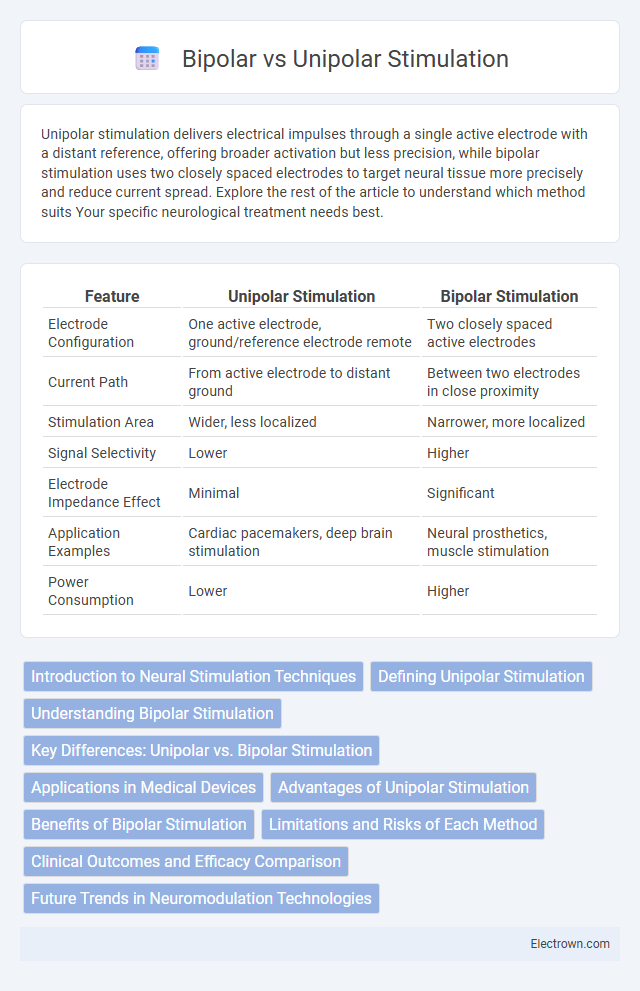Unipolar stimulation delivers electrical impulses through a single active electrode with a distant reference, offering broader activation but less precision, while bipolar stimulation uses two closely spaced electrodes to target neural tissue more precisely and reduce current spread. Explore the rest of the article to understand which method suits Your specific neurological treatment needs best.
Table of Comparison
| Feature | Unipolar Stimulation | Bipolar Stimulation |
|---|---|---|
| Electrode Configuration | One active electrode, ground/reference electrode remote | Two closely spaced active electrodes |
| Current Path | From active electrode to distant ground | Between two electrodes in close proximity |
| Stimulation Area | Wider, less localized | Narrower, more localized |
| Signal Selectivity | Lower | Higher |
| Electrode Impedance Effect | Minimal | Significant |
| Application Examples | Cardiac pacemakers, deep brain stimulation | Neural prosthetics, muscle stimulation |
| Power Consumption | Lower | Higher |
Introduction to Neural Stimulation Techniques
Neural stimulation techniques such as unipolar and bipolar stimulation are essential for modulating nerve activity in medical and research settings. Unipolar stimulation uses a single active electrode with a distant reference, creating a broad electric field ideal for widespread nerve activation. Bipolar stimulation employs two closely spaced electrodes, delivering more localized and controlled stimulation, which can enhance precision and reduce unintended effects on surrounding tissue.
Defining Unipolar Stimulation
Unipolar stimulation involves delivering electrical impulses through a single active electrode with a distant reference electrode, typically implanted in soft tissue or on the device casing. This method creates a larger electrical field, affecting a broad area of neural tissue, which can be advantageous for targeting wider nerve regions. It contrasts with bipolar stimulation, where current flows between two closely spaced electrodes, focusing stimulation on a more localized neural target.
Understanding Bipolar Stimulation
Bipolar stimulation involves delivering electrical pulses between two closely spaced electrodes on the same lead, creating a confined and localized electrical field that targets specific neural tissue more precisely. This method reduces current spread to surrounding areas, enhancing stimulation accuracy and minimizing side effects compared to unipolar stimulation, which uses a single contact and a distant reference electrode. Understanding bipolar stimulation helps you optimize neuromodulation therapies for conditions like Parkinson's disease and chronic pain by providing improved signal specificity and control.
Key Differences: Unipolar vs. Bipolar Stimulation
Unipolar stimulation uses a single active electrode with the return path located remotely, typically on the device casing, creating a larger, diffuse electrical field. Bipolar stimulation involves two closely spaced electrodes, one active and one return, generating a more focused and localized electrical field. This difference impacts clinical outcomes by influencing the precision of neural activation and potential side effects.
Applications in Medical Devices
Unipolar stimulation, involving a single active electrode with a distant reference, is widely employed in cardiac pacemakers to monitor and regulate heart rhythms due to its simplicity and lower energy consumption. Bipolar stimulation uses closely spaced electrodes, offering more precise, localized electrical delivery, essential in deep brain stimulation for movement disorders like Parkinson's disease to minimize side effects and improve therapeutic outcomes. Both methods are critical in cochlear implants, with unipolar configurations enhancing broad signal reach and bipolar setups ensuring targeted auditory nerve activation for clearer sound perception.
Advantages of Unipolar Stimulation
Unipolar stimulation offers enhanced spatial precision by using a single active electrode and a distant reference, reducing the risk of current spread and unwanted muscle activation. This method enables lower power consumption, which extends battery life in implantable devices such as deep brain stimulators and spinal cord stimulators. Clinicians favor unipolar setups for their simplicity, ease of programming, and predictability in therapeutic effects.
Benefits of Bipolar Stimulation
Bipolar stimulation offers enhanced spatial precision by delivering electrical impulses between two closely spaced electrodes, reducing current spread and minimizing activation of unintended neural pathways. This targeted approach improves therapeutic outcomes and decreases side effects in neuromodulation treatments. Your ability to achieve more selective stimulation makes bipolar configurations advantageous for clinical applications requiring precise neural control.
Limitations and Risks of Each Method
Unipolar stimulation carries risks of current spread causing unintended muscle activation and higher chance of tissue damage due to larger stimulation fields. Bipolar stimulation limits current spread with more localized effects but may require higher currents, increasing battery consumption and potential for electrode corrosion. Both methods face challenges in balancing effective neural activation with minimizing adverse effects like pain or nerve injury.
Clinical Outcomes and Efficacy Comparison
Unipolar stimulation, with its broader electric field, tends to provide more extensive neural activation, potentially improving pain relief in certain clinical scenarios but increasing the risk of side effects such as paresthesia. Bipolar stimulation offers more localized, targeted activation, enhancing precision and reducing unwanted stimulation, often leading to better patient satisfaction and fewer adverse effects. Your choice between unipolar and bipolar stimulation should consider the specific clinical condition and desired therapeutic outcomes for optimizing efficacy.
Future Trends in Neuromodulation Technologies
Emerging neuromodulation technologies increasingly favor precise bipolar stimulation over traditional unipolar approaches to enhance spatial selectivity and reduce side effects in treatments like deep brain stimulation (DBS). Innovations such as closed-loop systems integrate real-time neural feedback to dynamically adjust stimulation parameters, optimizing therapeutic outcomes. Advances in miniaturized, implantable devices and machine learning algorithms further propel the customization and efficacy of bipolar neuromodulation therapies in managing neurological disorders.
Unipolar vs Bipolar Stimulation Infographic

 electrown.com
electrown.com